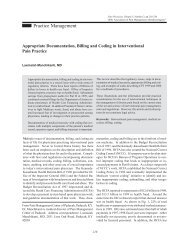ASIPP Practice Guidelines - Pain Physician
ASIPP Practice Guidelines - Pain Physician
ASIPP Practice Guidelines - Pain Physician
You also want an ePaper? Increase the reach of your titles
YUMPU automatically turns print PDFs into web optimized ePapers that Google loves.
Manchikanti et al • <strong>ASIPP</strong> <strong>Practice</strong> <strong>Guidelines</strong><br />
54<br />
them underwent subsequent surgery or other non-surgical<br />
treatment. Ninety-one percent of the patients in the treated<br />
group improved at three months, whereas 74% of the patients<br />
in the control group improved; however; there was<br />
only one patient in the treated group with severe pain, in<br />
contrast to six in the control group (2% vs. 16%).<br />
Ridley et al (564) corroborated the findings of Dilke et al<br />
(561) in 35 patients with sciatica in a randomized study<br />
that compared an epidural injection of 80 mg of methylprednisolone<br />
in 10 mL of normal saline to injection of 2<br />
mL of normal saline into interspinous ligament. They reported<br />
improvement in 90% of the patients in the treated<br />
group compared to 19% in the control group at one and<br />
two weeks following treatment, which was maintained up<br />
to 12 weeks but deteriorated by 24 weeks to pre-treatment<br />
levels.<br />
Carette et al (258) in a randomized, double-blind trial administering<br />
up to three epidural injections of methylprednisolone<br />
acetate (80 mg and 8 mL of isotonic saline) or<br />
isotonic saline (1 mL) to 158 patients with sciatica due to<br />
a herniated nucleus pulposus, reported negative results. The<br />
patients were evaluated utilizing Oswestry Disability Scores<br />
with follow-up at 3, 6, and 12 weeks after treatment. There<br />
were 78 patients in the treatment group and 80 patients in<br />
the placebo group, with L4/5 disc herniation in 50% and<br />
L5/S1 disc herniation in 46% of the patients. After 6 weeks,<br />
a significant difference was seen with improvement in leg<br />
pain in the methylprednisolone group. However, after 3<br />
months, there were no significant differences between<br />
groups. At 12 months, the cumulative probability of back<br />
surgery was equal in both groups.<br />
Snoek et al (567) studied 51 patients with lumbar root compression<br />
documented by neurological deficit and a concordant<br />
abnormality noted on myelography. They compared<br />
the effects of 80 mg of methylprednisolone (2 mL)<br />
and 2 mL of normal saline injected into the epidural space<br />
by the lumbar route. They found no significant differences<br />
between the two groups with respective relief of pain and<br />
a variety of physical parameters.<br />
Cuckler et al (560), in a prospective, randomized, doubleblind<br />
trial, evaluated 73 patients, comparing 7 mL of methylprednisolone<br />
(80 mg with procaine) and 7 mL of normal<br />
saline with procaine. The patients were suffering with<br />
radicular pain due to either acute herniated nucleus<br />
pulposus or spinal stenosis. They reported no significant<br />
differences in outcomes. This study was considered negative,<br />
condemning lumbar epidural steroid injections.<br />
Klenerman et al (563) randomized patients with sciatica<br />
into four treatment groups: epidural steroid injection, epidural<br />
saline, epidural bupivacaine and needling with a<br />
Touhy needle inserted into the interspinous ligament. The<br />
results were the same in the four treatment groups, with<br />
approximately 75% of the patients responding to the treatments.<br />
Serrao et al (566) evaluated the effectiveness of epidural<br />
steroid injections compared to subarachnoid midazolam<br />
in mechanical low back pain, concluding that epidural steroid<br />
injections are comparable to subarachnoid midazolam<br />
in patients with mechanical low back pain.<br />
Stav et al (570) studied 52 patients with chronic, resistant<br />
cervical brachialgia in a randomized, controlled study.<br />
They divided patients into two groups, with 25 patients in<br />
Group A who were treated with cervical epidural steroid<br />
and lidocaine injections, and 17 patients in Group B who<br />
were treated with steroid and lidocaine injections into the<br />
posterior neck muscles. One to three injections were administered<br />
at two week intervals, according to the clinical<br />
response. All patients continued with their various prestudy<br />
treatments: nonsteroidal anti-inflammatory drugs,<br />
nonopioid analgesics, and physiotherapy. One week after<br />
the last injection, very good and good pain relief were reported<br />
in 76% of the patients in Group A, as compared to<br />
36% of the patients in Group B. At one year 68% of the<br />
Group A patients continued to have very good and good<br />
pain relief, whereas only 12% of Group B patients reported<br />
similar pain relief, with statistically significant differences.<br />
They also reported that they were unable to achieve significant<br />
improvement of tendon reflexes or of sensory loss<br />
in both groups; but the increase in the range of motion, the<br />
percentage of the patients who were able to decrease their<br />
daily dose of analgesics, and recovery of the capacity for<br />
work was significantly better in Group A.<br />
Castagnera et al (569) evaluated long term results of cervical<br />
epidural steroid injection, with and without morphine,<br />
in chronic cervical radicular pain in 24 patients, without<br />
need of surgery, but suffering for more than 12 months<br />
from cervical radicular pain, in a prospective randomized<br />
study. The patients were randomly allocated into two<br />
groups: the steroid group, with 14 patients receiving an<br />
equivalent volume of 0.5% lidocaine plus triamcinolone<br />
acetonide (10 mg per mL) and the steroid plus morphine<br />
group, with 10 patients receiving the same combination<br />
plus 2.5 mg of morphine sulfate. The success rate was<br />
79% in the steroid group and 80% in the steroid plus morphine<br />
group. They reported an initial success rate of 96%,<br />
<strong>Pain</strong> <strong>Physician</strong> Vol. 4, No. 1, 2001
















